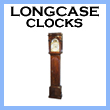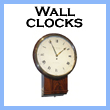
Mobile: 07860 230888
osame2@aol.com

About Bracket Clocks
Bracket clocks are formed of two matching parts, i.e the clock and a small decorative shelf. The material used is nearly always wood which can be decorated with brass, or veneer or ormolu mount (a form of guilding). The earlier bracket/table clocks were embellished with pillars on either sides and a pediment. These clocks often had repeating work, sometimes quarterly.
The 17th and 18th century English bracket/table clocks had carrying handles. For practical reasons, the handle was needed to carry the clock downstairs during the day and upstairs at night. Being an expensive item at the time, there would probably be only one per household, hence the need to be transportable.
The name "bracket clock" was really introduced in the 19th century. Paradoxal as it seems, this type of clock was never used on a bracket. A more suitable designation, according to the British Museum, would be spring clock (coiled spring introduced around 1480, replaced by the fusee) or table clock. To further the idea, the 17th and 18th century table clocks have lovely engraved backplates which would indicate that they have been designed to be seen. On the contrary, the clocks specifically made to sit on a bracket have plain backplates.
View all our Bracket Clocks.







